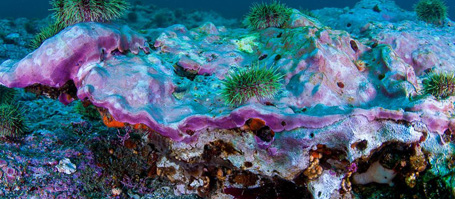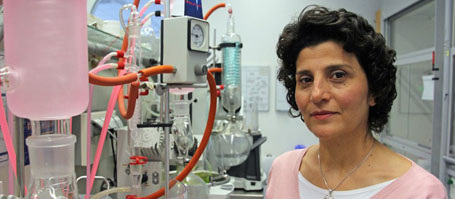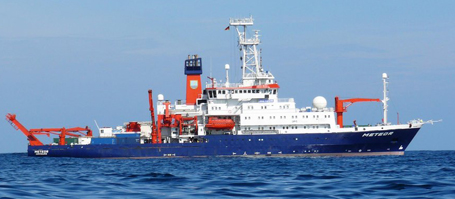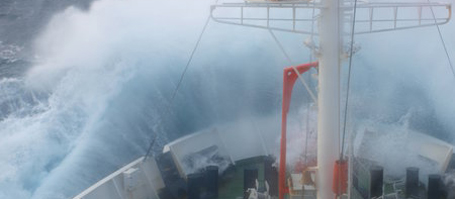Next to global warming, ocean acidification is currently considered as the second major carbon dioxide problem. With the increase of carbon dioxide (CO2) in the atmosphere larger quantities of the gas are getting into the seawater, too. There it forms carbonic acid, which lowers the pH value of the oceans. The long-term effects of this process on marine ecosystems are still unknown. Research is facing a fundamental problem: Measurements of pH values in the oceans have started only a few decades ago, in some areas only a few years ago. What were the pH values organisms coped with 100, 200 or 1000 years ago?
Scientists from the GEOMAR Helmholtz Centre for Ocean Research Kiel (Germany) have now succeeded together with partners from the Universities of Bristol (UK), the University of Toronto (Canada) and the University of Maine (USA) in reconstructing the pH values of the northern Pacific ocean over the past 120 years with a monthly resolution. They analyzed samples of a coralline alga with an innovative combination of laser technology and isotope analytics. “There have not been such reconstructions from the high northern latitudes until now. The new data are important in order to assess the potential impacts of ocean acidification. The technique we used opens up new possibilities for environmental reconstruction,” says Dr. Jan Fietzke from GEOMAR. He is the lead author of the study, which has been published in the current issue of the international journal Proceedings of the National Academy of Sciences (PNAS).
For their study, which was partly funded by the German joint project “Biological Impact of Ocean Acidification” (BIOACID), the international research team used samples from specimen of the algae Clathromorphum nereostratum. These algae create massive reefs in the northern Pacific Ocean and in the Bering Sea on the ocean floor, where they form solid calcium carbonate structures. In these formations very fine growth rings are visible to the naked eye. These rings – similar to growth rings of trees – contain information about the respective environmental conditions.
To decode this information the researchers used a procedure called laser ablation. A special laser shoots material from the sample at previously well-defined positions. “A single sample point is just one-tenth of a millimeter wide,” says Dr. Fietzke. The removed material is automatically transported into a mass spectrometer, where different isotope ratios can be measured. For the current study, the group used two isotopes of the element boron. The relationship between them is considered a reliable indicator of the pH value of seawater.
The scientists found that the pH value in the North Pacific has actually been declining since the late 19th century, which means the water is acidifying. “The trend fits well to the rising carbon dioxide levels in the atmosphere," says co-author Dr. Federica Ragazzola, a biologist now based at the University of Portsmouth. At the same time the exact monthly resolution of the analysis also revealed strong variations in pH within one year. They probably originate from the fact that large kelp forests grow in the region the samples came from. “In spring and summer the kelp consumes large amounts of CO2. This means there is less carbon dioxide in the water and the pH rises,” says the biologist.
The participating scientists say they are fascinated about the possibilities of the laser-ablation method. “We get extremely high-resolution results, which can be evaluated visually. You do not have to compare raw numbers”, says Dr. Fietzke.
The present study will only be the beginning. “These and similar types of coralline algae are living in all oceans at high latitudes. They can grow thousands of years. Thanks to laser ablation techniques, in the future we can use other samples to look much further back into the past to reconstruct pH and other environmental parameters in detail," says the physicist Fietzke.
BIOACID in brief:
Under the umbrella of BIOACID (Biological Impacts of Ocean Acidification), 14 institutions examine how marine ecosystems react to ocean acidification, how this affects the food web and the exchange of material and energy in the ocean and how the changes influence the socio-economic sector. The project started in 2009 and entered its second three-year funding period in September 2012. The Federal Ministry of Education and Research (BMBF) supports the current work with 8.77 million Euros. The work is coordinated by GEOMAR Helmholtz Centre for Ocean Research Kiel. A list of member institutions, information on the scientific programme and the BIOACID committees as well as facts about ocean acidification can be found on the website www.bioacid.de.
Reference:
Fietzke, J., F. Ragazzola, J. Halfar, H. Dietze, L. C. Foster, T. H. Hansteen, A. Eisenhauer, R. S. Steneck (2015): Century scale trends and seasonality in pH and temperature for shallow zones of the Bering Sea. Proceedings of the National Academy of Sciences (PNAS), Early Edition
http://dx.doi.org/10.1073/pnas.1419216112
Contact:
Jan Steffen (GEOMAR, Communication & Media), Tel.: 0431 600-2811
presse@geomar.de
…



